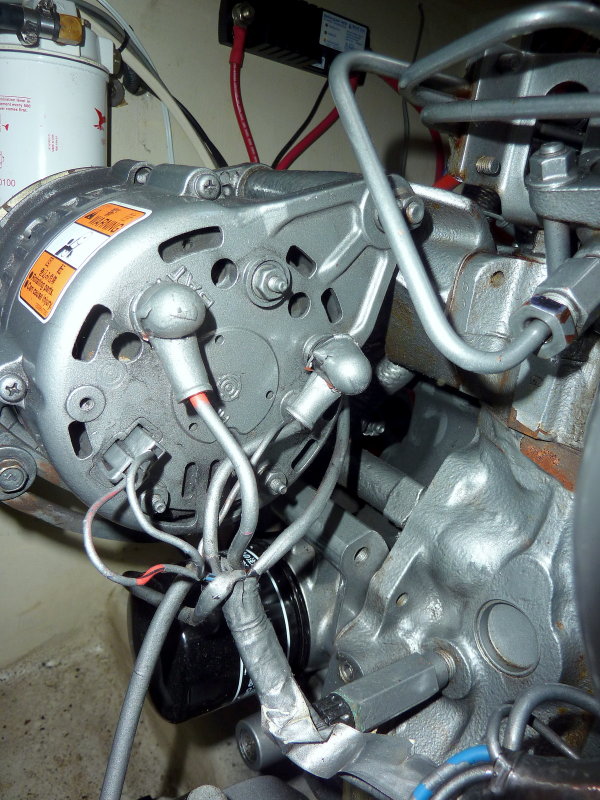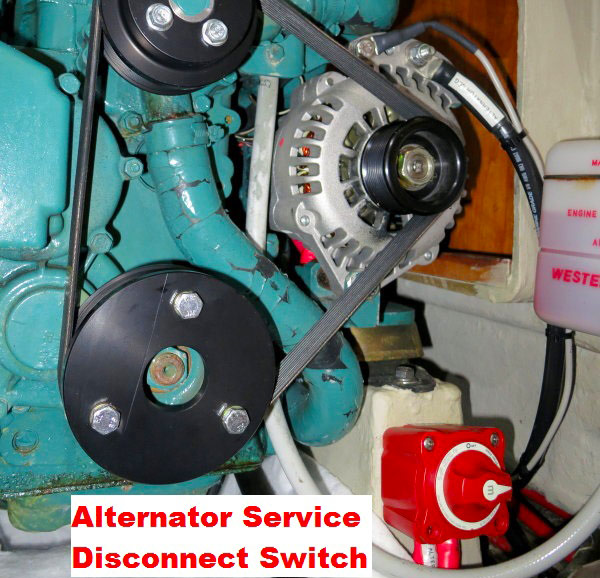A battery decides how much amperage it will accept, at the voltage( electrical pressure) reaching the battery terminals.
How much the battery accepts depends on its size, its state of charge, its health and its temperature. Al these factors influence its internal resistance.
So say one has an alternator which at idle, can make 80 amps if fully fielded and 140 amps at higher rpms.
Say their battery was so depleted from leaving lights on until the vehicle would not start, but otherwise is otherwise still healthy.
Say the vehicle needs 20 amps to power the ignition and fuel pump.
One jumpstarts the vehicle, removes jumper cables and the jumpee vehicle's voltage regulator is seeking 14+ volts. 20 amps are needed to run the engine, and the alternator maxes out at 80 amps at idle. That leaves 60 amps charging current available for battery charging.
If it were a large newish healthy group 27 battery, which is about 100 amp hours of capacity, 100% depleted. it would be sucking up those 60 amps for about 20 minutes before voltage rose to 14.4v. Maxing out the alternator, heating it up.
When the maximum voltage allowed is reached, amperage into the battery tapers. When it tapers to very low levels at high voltages, then it can be considered fully charged.
The best of AGM batteries, cannot be recharged from well below 50% to 100% in less than 5.5 hours, assuming a huge amperage source seeking and holding 14.4v+ the entire time.
Most vehicle voltage regulators, will never allow this voltage for this duration. Vehicle voltage regulation is all about Never Overcharging while powering all DC loads, it is not about quickly returning a battery to full charge.
Idling to recharge a well depleted battery, is very hard on the alternator, but less so if the voltage regulator drops max allowable voltage to 13.6v or less. A depleted battery getting 14.7v will require 3x as many Amps as one getting 13.6v at battery terminals but this is closer to 2x when the depleted battery is aged.
Voltage regulation is everything regarding battery charging efficacy.
The 10% charge rate recommended, assumes one has overnight to plug in and recharge, at least 12 hours.
The alternator obviously can and does greatly exceed this 'recommended' rate when charging a well depleted battery.
Some AGMS when deeply cycled say no less than 40%.
Table 3 shows the minimum charge currents for the full range of ODYSSEY® batteries when they are used in deep cycling application. When using a charger with the IUU profile, we suggest the following ratings for your ODYSSEY battery. Note the charger current in the bulk charge mode must be 0.4C10 or more
page 16
One of the best respected deep cycle AGMS says no less than 20% and MOre is better, always.
Page 20:
Most batteries have zero issues exceeding a 10% charge rate, the exceptions are hot batteries in hot climates and a charging source still seeking/holding high voltages on the hot battery.
Vehicle voltage regulation varies widely, as to what voltage is allowed and for how long. Most vehicular Voltage regulators are quite stupid, and the smarter ones are not worried about quick and full battery charging, but when to allow higher voltages and amperage to best maximize fuel economy .
An alternator voltage regulator designed to maximize battery charging, is a rather complicate device, with one or 2 battery temperature sensors, alternator temperature sensor, and user programmable features to derate the alternator should the belts not be up to the task of spinning it, at 160+ amps of output, or the alternators or battery's get too hot.
The Balmar MC-614 is one such Voltage regulator, It is about 430$ with the temperature sensors. It is almost infinitely adjustable, although the programming interface is a bit clunky. I am installing one now on about 4000$ worth of Lifeline AGM batteries. With this much battery capacity without the features of the Balmar the depleted battery bank would smoke an internally regulated 14v alternator, and the alternator would overcharge fully charged batteries holding it at 14v for hours on end. If a thermally regulated voltage regulator within the alternator, it would lower the voltage so much as to do very little charging of depleted batteries while underway.
Here are some good articles about alternators and their voltage regulation. Mostly for boats but there's a lot of crossover.
A Deep Cycle Battery Assassin The alternator pictured here helped to destroy a very expensive bank of TPPL AGM batteries in under two years. These batteries need an absorption voltage of 14.7V. The highest voltage I recorded on this vessel was 13.58V at the battery terminals. At this
marinehowto.com
Regulator Sensing Voltage at Alternator End The topic of wiring a high performance alternator regulator, and doing it correctly, comes up a lot. One of the most confusing and often misunderstood areas, that can bite into your charge performance, is incorrect voltage sense wiring. This short...
marinehowto.com
A few takeaways, is that most people have very little understanding about batteries and charging systems, voltage and amperage.
A healthy depleted battery can accept lots of amperage.
An Alternator can be a huge source of amperage. The greater the electrical pressure( voltage) difference between source( alternator) and load( battery) the more amperage can flow into battery, upto the amperage limits of the charging source.
Slow spinning alternator might be able to make a lot of amperage and a lot of heat. Idling to charge a well depleted healthy battery can be very hard on the alternator. Underhood airflow from driving and higher alternator fan speeds help keep it cooler.
Battery charging takes a lot of time. With huge amperage available on can get from 0% to 80% quickly, but that last 20% takes no less than 3.5 hours, and likely a lot longer than that. The less healthy the battery ,the longer it takes to reach 100% and unless it is held at higher voltages it will never reach 100% state of charge and all lead acid batteries want to be returned to 100%, ideally, as soon as possible as often as possible, and it is more important that this occurs, the deeper the battery is discharged. take a battery to 10% charge it to 30%, and it will easily start the vehicle, but it is one unhappy battery that is losing capacity just sitting there 30% charged.
100% state of charge does not mean 100% capacity. When new the battery tank might have held 20 gallons, when older it might only hold 10 gallons, but the fill port is occluded, and there is a small leak, so it takes longer to recharge and wastes more in the process( as heat), even though it has less capacity.
A depleted battery is a load, but unlike most other vehicular loads, the load it presents is highly variable depending on the its size health state of charge and temperature and the voltage sought by the voltage regulator.
Often compromised batteries discharged below 11 volts react a bit differently. they will only accept a few amps at most initially, and then start increasing acceptance as they wake up. This can trick the observer of voltmeter and ammeter, or smart charger, into believing that which is not true.
Just yesterday I was brough a 5 month old group 27 interstate starter battery( ~100 amp hour capacity) that is foolishly being deeply cycled, discharged to 8v or less over 3 weeks.. Hooking it to a 100 amp power supply set to 13.2v, it only accepted 3 amps initially, crank it to 14.7v and 3.2 amps. lower it back to 13.2 amps and 2 minutes later it is taking 15 amps, 2 minutes after that it is taking 25 amps, 2 minutes after than 34 amps. I lowered voltage to 11.6v and it was taking ~18 amps, and walked away, an hour later I came back it was accepting 0.2 amps, and I raised voltage to 14.7, 47 amps flowing. too much, lower to 13.8v 15 amps, walk away. One hour later accepting 1 amp, raise voltage to 14.5v 17 amps, walk away.
4 hours later still accepting 4.53 amps@ 14.5v , had only tapered 0.5 amps in 30 minutes. I told battery owner to let me keep it overnight, until amps stop tapering, but he needed battery, so I gave it back to him somewhere around 90% charged. Battery is doomed to a short life, but doomed to a shorter one than if were allowed to keep it at 14.5v for 6+ more hours.
It took 68 amp hours to charge ( Some % of that turned to heat) it to this level, and likely had 100amp hours capacity when it was new. If it were new and 100% depleted, I could have recharged it fully and had 2 hours left over before he picked it up. I could have charged it faster had I not lowered the pressure, but it was a hot day and battery was well over 100f when I took it off the charger. It would likely have gotten well over 120f had I charged it faster and no Lead acid battery should be charged at that temperature, whether healthy or sulfated.
Though high temps do stand a battery chance of desulfating them but @ 120 F stop and let it cool before resuming.


